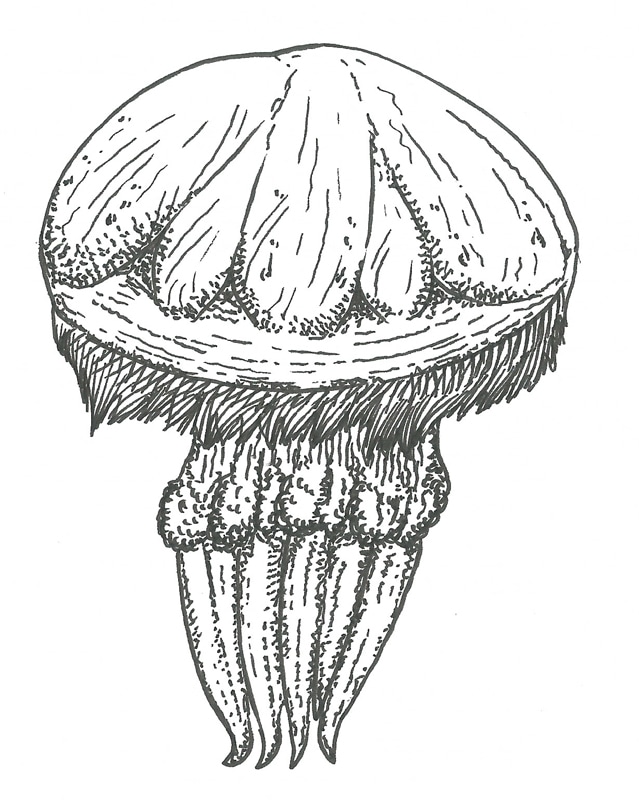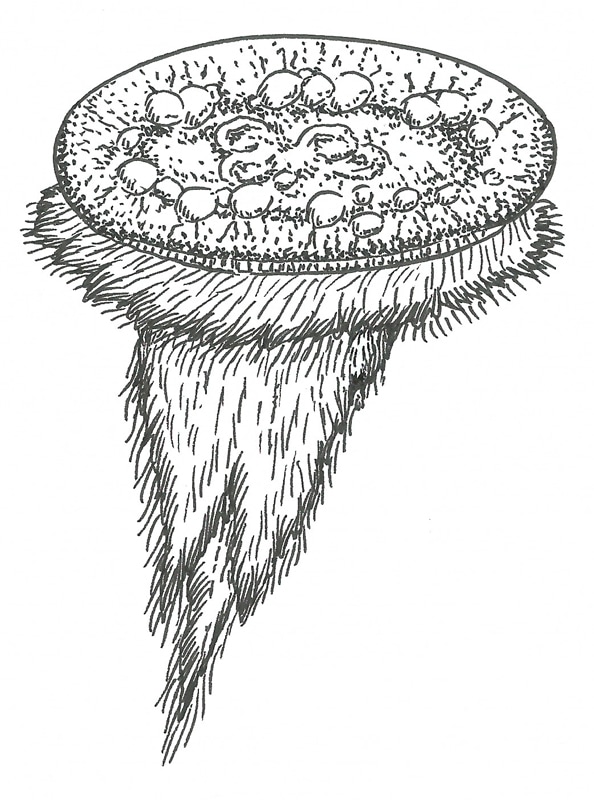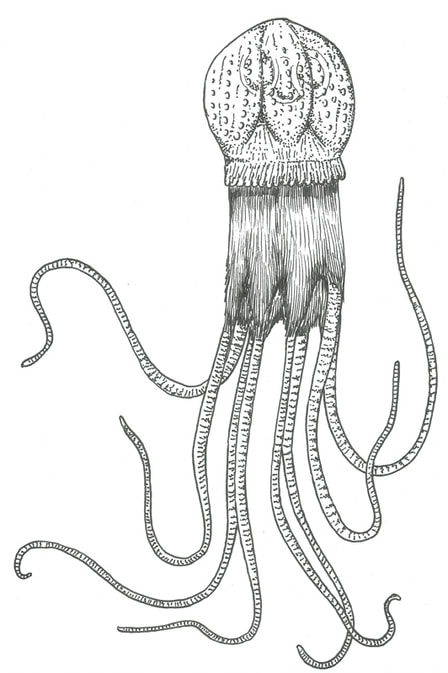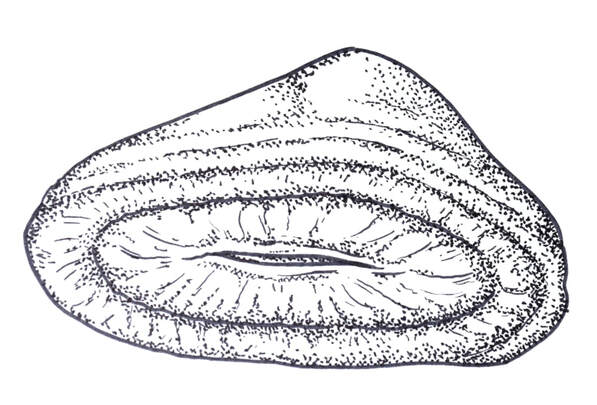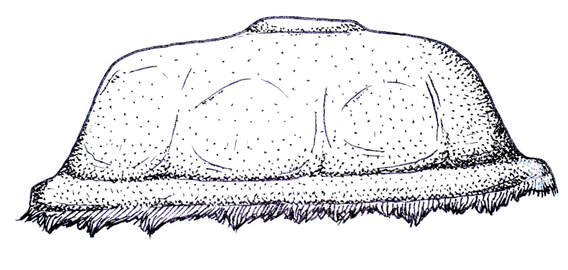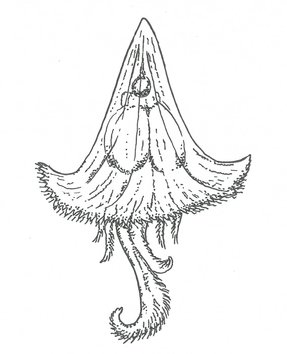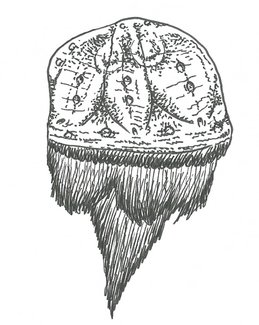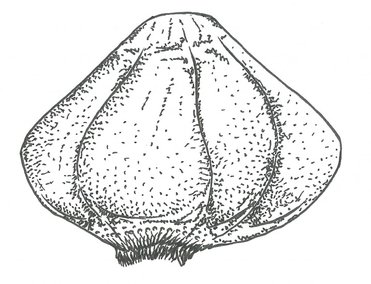Air Jellies - Medusozoa
These creatures are typical sky-jellyfish. They are held aloft by large bladders which contain lighter-than-air gases, produced by specialized glands within their bodies. As with most critters, their flesh is also imbued with tiny pockets of air, which lighten the body considerably. Modern forms mainly drift about in the air, using their long trails of tentacles to trap smaller creatures. However the ancestral form, as with all air-jellies, must have been a photosynthesizer, which would explain why some forms still photosynthesize to a smaller degree, to augment their diet.
Sky Medusae –
Source: Numerous notable photographs of mushroom-like cloud forms, dates unknown.
Here are two relatively typical sky medusae. Common forms such as this vary from 5 to 30 meters across, and are relatively slow-moving. They feed mainly on small airborne critters, which they snag with their curtain-like tentacles. When spotted from the ground, sky medusae typically resemble large, mushroom shaped clouds suspended high in the sky. Usually their flesh is either light blue or white. Sky medusae typically inhabit the lower stratosphere and upper troposphere.
Source: Numerous notable photographs of mushroom-like cloud forms, dates unknown.
Here are two relatively typical sky medusae. Common forms such as this vary from 5 to 30 meters across, and are relatively slow-moving. They feed mainly on small airborne critters, which they snag with their curtain-like tentacles. When spotted from the ground, sky medusae typically resemble large, mushroom shaped clouds suspended high in the sky. Usually their flesh is either light blue or white. Sky medusae typically inhabit the lower stratosphere and upper troposphere.
Octo-jelly –
Source: Sighting by John Harrison, Conisholme England, January 4th 2009.
This is a larger and much more aggressive variety of sky-medusa, at about 100 meters full length. It is able to snare and subdue quite large flying prey with its 8 long, powerful tentacles. When irritated or surprised, it is able to glow a bright, vivid blue.
Source: Sighting by John Harrison, Conisholme England, January 4th 2009.
This is a larger and much more aggressive variety of sky-medusa, at about 100 meters full length. It is able to snare and subdue quite large flying prey with its 8 long, powerful tentacles. When irritated or surprised, it is able to glow a bright, vivid blue.
Bursa Sky Creature -
Source: Well-documented sighting by a large number of people in broad daylight, flying in the sky over the city of Bursa, Turkey, January 2023.
This sky medusa has an unusual appearance due to peculiarities of its diet and feeding. Buoyed by numerous internal gas-bladders, it drifts through the upper troposphere in search of other slow-moving sky-creatures to consume. At up to 80 meters across, it is quite large for a sky medusa, but lacks tentacles entirely, and is able to engulf and digest creatures almost as large as itself. A sphincter-like mouth is located on the underside, which can open very wide in order to engulf prey.
Source: Well-documented sighting by a large number of people in broad daylight, flying in the sky over the city of Bursa, Turkey, January 2023.
This sky medusa has an unusual appearance due to peculiarities of its diet and feeding. Buoyed by numerous internal gas-bladders, it drifts through the upper troposphere in search of other slow-moving sky-creatures to consume. At up to 80 meters across, it is quite large for a sky medusa, but lacks tentacles entirely, and is able to engulf and digest creatures almost as large as itself. A sphincter-like mouth is located on the underside, which can open very wide in order to engulf prey.
Saucer type A2, C9, F9, G10 -
Source: Many separate sightings, commonly reported in UFOlogy circles.
This large medusa is mostly found in the mid and upper stratosphere. A consumer of aeroplankton, it is able to propel itself slowly by pulsing, or by spinning itself quickly using jets of expelled air. This creature seems to correspond to numerous flying saucer types, it commonly grows as much as 5 meters across.
Source: Many separate sightings, commonly reported in UFOlogy circles.
This large medusa is mostly found in the mid and upper stratosphere. A consumer of aeroplankton, it is able to propel itself slowly by pulsing, or by spinning itself quickly using jets of expelled air. This creature seems to correspond to numerous flying saucer types, it commonly grows as much as 5 meters across.
Kasa-obake –
Source: Japanese myth.
The Kasa-obake is mainly known from the myths of the Japanese, but these appear to be individuals which have become stranded on the ground or injured. Typically these sky jellies live in the very upper reaches of the troposphere, flapping their umbrella-like hoods to stay aloft. Myths often liken them to living umbrellas, which they do resemble in size and shape.
Source: Japanese myth.
The Kasa-obake is mainly known from the myths of the Japanese, but these appear to be individuals which have become stranded on the ground or injured. Typically these sky jellies live in the very upper reaches of the troposphere, flapping their umbrella-like hoods to stay aloft. Myths often liken them to living umbrellas, which they do resemble in size and shape.
Kurage-no-hinotama –
Source: Japanese myth.
These basketball-sized jellies are typically found in the upper troposphere, but due to their relatively weak propulsion, they become stranded on the ground somewhat more often.
Source: Japanese myth.
These basketball-sized jellies are typically found in the upper troposphere, but due to their relatively weak propulsion, they become stranded on the ground somewhat more often.
The Blob –
Source: Sighting in Whitby, England, 2006.
This relatively small jelly is black in colour and about 4 feet tall by 3 feet across. It appears bloated and leathery on the outside. The interior of this creature is filled with numerous gas bladders, which it is able to fill and empty in sequence, allowing it to glide along smoothly and silently. Though initially spotted on the ground, this form usually inhabits the mid stratosphere.
Source: Sighting in Whitby, England, 2006.
This relatively small jelly is black in colour and about 4 feet tall by 3 feet across. It appears bloated and leathery on the outside. The interior of this creature is filled with numerous gas bladders, which it is able to fill and empty in sequence, allowing it to glide along smoothly and silently. Though initially spotted on the ground, this form usually inhabits the mid stratosphere.
